
Arkansas Comprehensive Testing, Assessment, and Accountability Program
Released Item Booklet
Algebra I
Mid-Year End-of-Course Examination
January 2008 Administration
This document is the property of the Arkansas Department of Education, and all rights of this document are
reserved by the Arkansas Department of Education. Arkansas public schools may reproduce this document
in full or in part for use with teachers, students, and parents. All other uses of this document are forbidden
without written permission from the Arkansas Department of Education. All inquiries should be sent to
Dr. Gayle Potter at the Arkansas Department of Education, 501-682-4558.
Arkansas Department of Education
A TAAP

Table of Contents
PAGE
PART I Overview.........................................................................................................................................1
Scoring Student Responses to Algebra I Open-Response Items................................................2
PART II Released Test Items with Correct Responses........................................................................3–11
Released Algebra I Items...........................................................................................................3–10
End-of-Course Mathematics Reference Sheet...............................................................................11
PART III Curriculum Framework........................................................................................................12–13
PART IV Item Correlation with Curriculum Framework .................................................................14–15
Released Items for Algebra I .........................................................................................................14
Non-Released Items for Algebra I.................................................................................................15
i

PART I Overview
The criterion-referenced tests implemented as part of the Arkansas Comprehensive Testing, Assessment, and
Accountability Program (ACTAAP) are being developed in response to Arkansas Legislative Act 35, which
requires the State Board of Education to develop a comprehensive testing program that includes assessment of
the challenging academic content standards defined by the Arkansas Curriculum Frameworks.
As part of this program, students in Arkansas public schools who had completed or were completing Algebra I
by the end of the first semester participated in the Algebra I Mid-Year End-of-Course Examination in January
2008.
This Released Item Booklet for the Algebra I Mid-Year End-of-Course Examination contains test questions or
items that were asked of students during the January 2008 operational administration. The test items included in
Part II of this booklet are some of the items that contributed to the student performance results for that
administration.
Students were given approximately an hour and a half each day to complete assigned test sessions during the
two days of testing in January 2008. Students were permitted to use a calculator for both multiple-choice and
open-response items. Students were also supplied with a reference sheet to be used so that all students would
have equal access to this information during testing. (See the reference sheet on page 11 of this booklet.) All of
the multiple-choice items within this booklet have the correct response marked with an asterisk (*).
The development of the Algebra I Mid-Year End-of-Course Examination was based on the Arkansas Algebra I
Mathematics Curriculum Framework. This framework has distinct levels: Strands to be taught in concert,
Content Standards within each Strand, and Student Learning Expectations within each Content Standard. An
abridged version of the Arkansas Algebra I Mathematics Curriculum Framework can be found in Part III of this
booklet. It is important to note that this abridged version lists only the predominant Strand, Content Standard,
and Student Learning Expectation associated with each item. However, since many key concepts within the
Arkansas Algebra I Mathematics Curriculum Framework are interrelated, in many cases there are other item
correlations or associations across Strands, Content Standards, and Student Learning Expectations.
Part IV of the Released Item Booklet contains a tabular listing of the Strand, Content Standard, and Student
Learning Expectation that each question was designed to assess. The multiple-choice and open-response items
found on the Algebra I Mid-Year End-of-Course Examination were developed in close association with the
Arkansas education community. Arkansas teachers participated as members of the Algebra I Content Advisory
Committee, providing routine feedback and recommendations for all items. The number of items associated
with specific Strands, Content Standards, and Student Learning Expectations was based on approximate
proportions suggested by the Content Advisory Committee, and their recommendations were accommodated to
the greatest extent possible given the overall test design. Part IV of the Released Item Booklet provides
Arkansas educators with specific information on how the Algebra I Mid-Year End-of-Course Examination items
align or correlate with the Arkansas Algebra I Mathematics Curriculum Framework to provide models for
classroom instruction.
1

2
PART I Scorin
g
Student Res
p
onses to Al
g
ebra I O
p
en-Res
p
onse Items
While multiple-choice items are scored by machine to determine if the student chose the correct answer from
four options, responses to open-response items must be scored by trained “readers” using a pre-established set
of scoring criteria.
The Arkansas Algebra I Rangefinding Committee assisted in the development of the scoring criteria. The
committee comprises active, Arkansas educators with expertise in mathematics education.
Reader Training
Before readers are allowed to begin assigning scores to any student responses, they go through intensive
training. The first step in that training is for the readers to read the Algebra I open-response items as they appear
in the test booklet and to respond—just as the student test takers are required to do. This step gives the readers
some insight into how the students might have responded. The next step is the readers’ introduction to the
scoring rubric. All of the specific requirements of the rubric are explained by the Scoring Director who has been
specifically trained to lead the scoring group. Then responses (anchor papers) that illustrate the score points of
the rubric are presented to the readers and discussed. The goal of this discussion is for the readers to understand
why a particular response (or type of response) receives a particular score. After discussion of the rubric and
anchor papers, readers practice scoring sets of responses that have been pre-scored and selected for use as
training papers. Detailed discussion of the responses and the scores they receive follows.
After three or four of these practice sets, readers are given “qualifying rounds.” These are additional sets of pre-
scored papers, and, in order to qualify, each reader must score in exact agreement on at least 80% of the
responses and have no more than 5% non-adjacent agreement on the responses. Readers who do not score
within the required rate of agreement are not allowed to score the Algebra I Mid-Year End-of-Course
Examination responses.
Once scoring of the actual student responses begins, readers are monitored constantly throughout the project to
ensure that they are scoring according to the criteria. Daily and cumulative statistics are posted and analyzed,
and Scoring Directors or Team Leaders reread selected responses scored by the readers. These procedures
promote reliable and consistent scoring. Any reader who does not maintain an acceptable level of agreement is
dismissed from the project.
Scoring Procedures
All student responses to the Algebra I Mid-Year End-of-Course Examination open-response test items are
scored independently by two readers. Those two scores are compared, and responses that receive scores that are
non-adjacent (a “1” and a “3,” for example) are scored a third time by a Team Leader or the Scoring Director
for resolution.
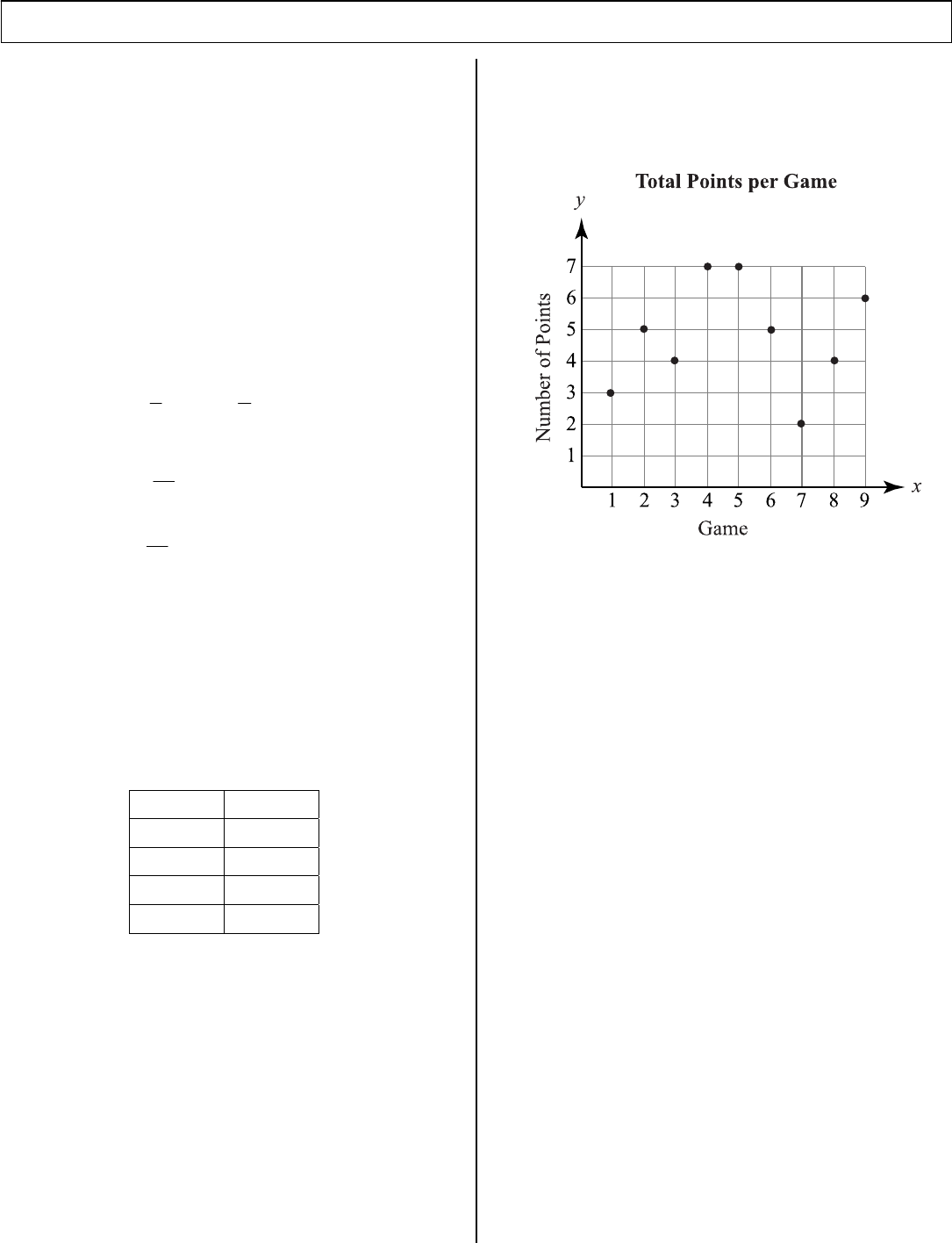
PART II Released Al
g
ebra I Items
ARAM06F0301NXXX-521B
1. Which set of points represents a function?
A. (0, 2) (1, 4) (2, 6) (0, 8)
* B. (–2, 4) (0,4) (2, 4) (4, 4)
C. (4, –2) (4, 0) (4, 2) (4, 4)
D. (–2, 2) (2, 2) (–2, –2) (2, –2)
ARAM06S0201NXXX-202D
2. What is the solution to the equation below?
3
5
x
+ 5 =
2
3
x
+ 3
A. x = –
11
1
19
B. x =
6
6
19
C. x = –4
* D. x = 30
ARAM06D0509Y567-567A
3. Which formula would not create the sequence
shown in the table below?
n T
n
1 19
2 24
3 29
4 34
* A. T
n
= 19 + 5n
B. T
n
= 14 + 5n
C. T
n
= 19 + 5(n – 1)
D.
1
1
19
5
nn
T
TT
−
=
⎧
⎪
⎨
=+
⎪
⎩
ARAM06D0501Y501-501D
4. The scatterplot below shows the number of
points the team scored in each of its games
this season.
What can be inferred from the scatterplot?
A. The team scored fewer points against
better opponents.
B. The team scored more points as the
season progressed.
C. The team’s highest point total was in
Game 3.
* D. The point totals showed no correlation.
ARAM06F0303NXXX-338C
5. The function f(x) = 2.15 + 0.15x describes
the cost of taxicab fare, where f(x) = cost of
the ride (in dollars), and x = mileage. If the
domain is {5, 10, 15, 20}, what is the range of
the given function?
A. {$19, $59, $85.67, $119}
B. {$2.31, $2.30, $2.30, $2.30}
* C. {$2.90, $3.65, $4.40, $5.15}
D. {$7.30, $12.30, $17.30, $22.30}
3
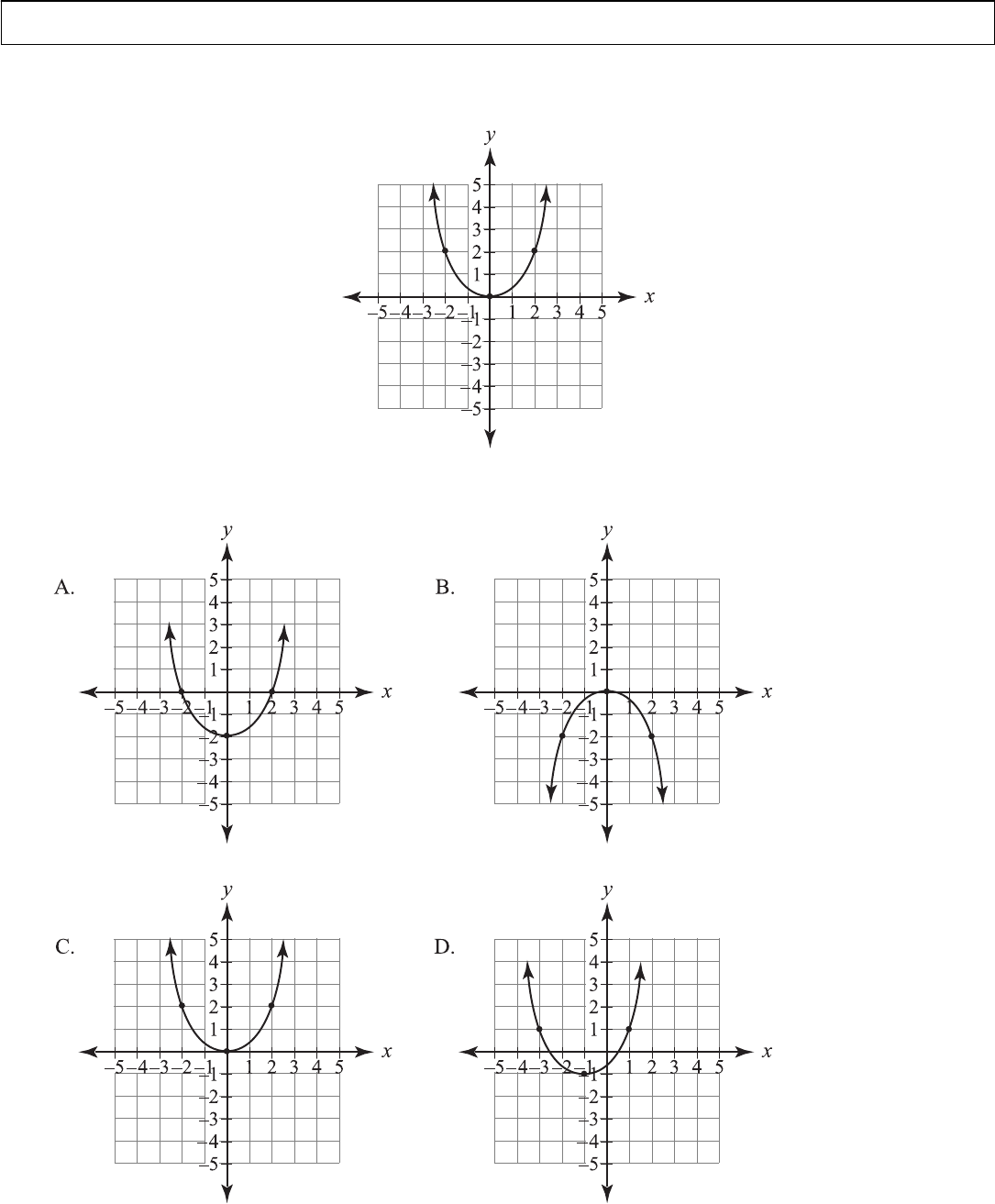
PART II Released Al
g
ebra I Items
ARAM06N0404Y419-419A
6. Which graph shows a vertical shift of the one below?
*
4
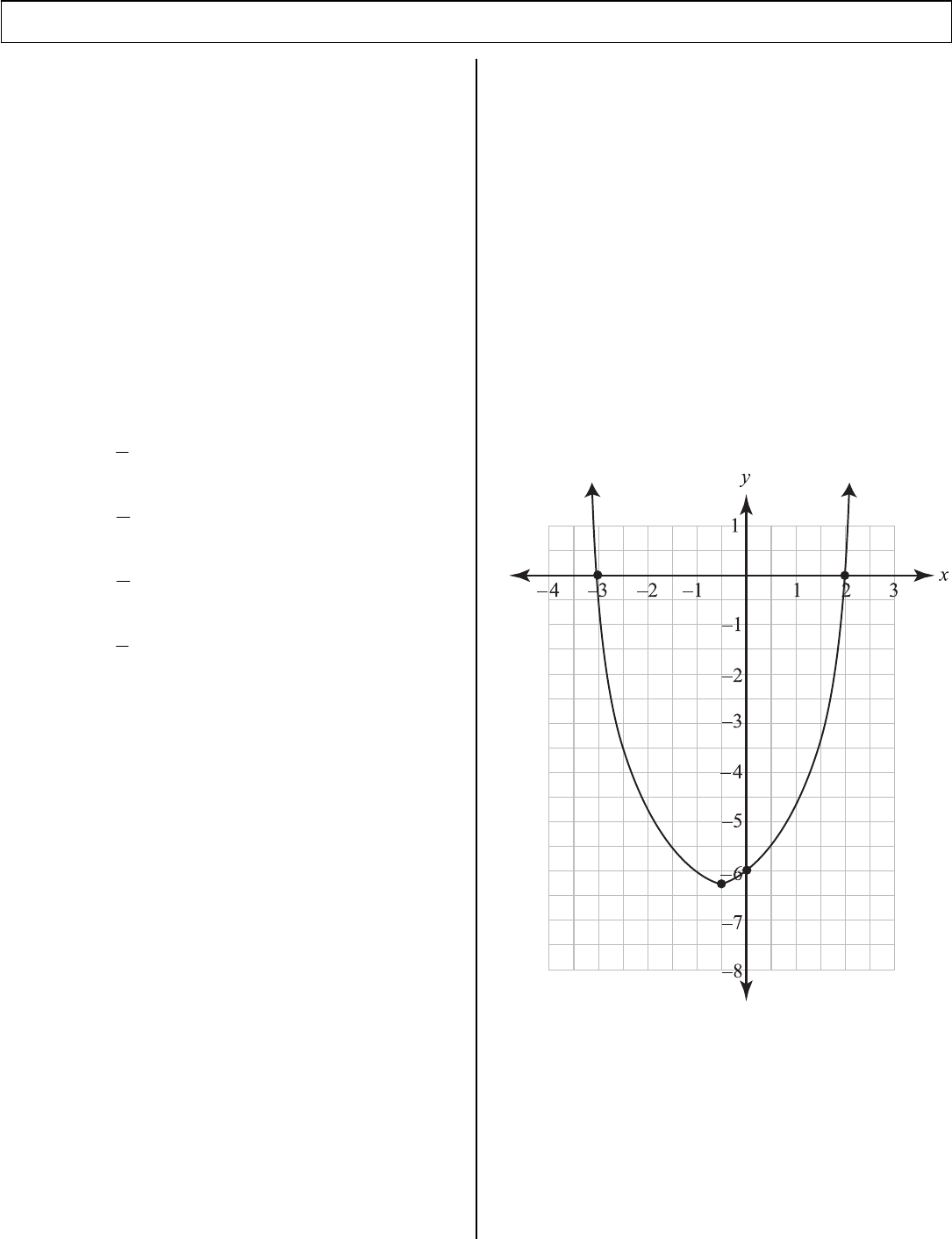
PART II Released Al
g
ebra I Items
ARAM06N0401NXXX-461B
7. What is the correct way to factor the
polynomial 8x
2
– 4x – 22?
A. 2(x
2
– x – 11)
* B. 2(4x
2
– 2x – 11)
C. (8x + 11)(x – 2)
D. 2(4x
2
+
2
x
+ 11)
ARAM06F0306NXXX-347A
8. What is the slope of the line passing through
points (6, –1) and (1, 8)?
* A.
9
5
−
B.
7
5
−
C.
5
7
−
D.
5
9
−
ARAM06D0502NXXX-574C
9. Given the matrices below, what is (2A – B)?
A = B =
258
734
⎡⎤
−
⎢⎥
−
⎢⎥
⎣⎦
98 3
06 7
⎡⎤
−
⎢⎥
−
⎢⎥
⎣⎦
A.
11 13 5
73
⎡⎤
−
⎢⎥
−
⎢⎥
⎣⎦
3
3
B.
13 18 13
73
⎡⎤
−
⎢⎥
−
⎢⎥
⎣⎦
* C.
13 18 13
14 0 1
⎡⎤
−
⎢⎥
−
⎢⎥
⎣⎦
D.
51813
14 0 15
⎡⎤
−−
⎢⎥
−
⎢⎥
⎣⎦
ARAM06F0305NXXX-344B
10. Sarah bought a $450 microwave on credit
from a local discount store. Interest will be
$12 per month. The equation that represents
Sarah’s bill is y = 12x + 450. What is the slope
of the equation?
A. 10
* B. 12
C. 450
D. 462
ARAM06N0402Y437-437C
11. The graph of y = x
2
+ x – 6 is shown below.
What are the coordinates of the zero(s) of the
equation?
A. (0, –6)
B. (–0.5, –6.25)
* C. (–3, 0), (2, 0)
D. (–2, 0), (3, 0)
5

PART II Released Al
g
ebra I Items
ARAM06D0504Y580-580A
12. The high temperatures shown below were recorded for the first two weeks in July.
Sun. Mon. Tue. Wed. Thur. Fri. Sat.
84
86 92 89 83 84 94 93
95 95 84 84 85 89
If the next four temperatures are 95, 95, 98, and 101, how will this change the mean and median of the
data already in the table?
* A. The mean and median will increase.
B. The mean and median will decrease.
C. The mean will increase and the median will decrease.
D. The median will increase and the mean will decrease.
ARAM06F0303NXXX-339B
13. If f(x) = 4x – 2 and g(x) = x
2
+ 3, what is the
value of f(4) + g(3)?
A. 23
* B. 26
C. 54
D. 97
ARAM06L0101NXXX-162B
14. A car’s efficiency, in mpg, is represented by
the expression –0.03s
2
+ 2.1s + 7, where s is
the speed of the car. If the car is traveling at a
speed of 60 mph, what is the car’s efficiency?
A. 7 mpg
* B. 25 mpg
C. 131 mpg
D. 135 mpg
ARAM06N0401NXXX-464A
15. Which is the complete factorization of the
polynomial x
2
+ 2x – 24?
* A. (x + 6)(x – 4)
B. (x – 6)(x + 4)
C. (x + 12)(x – 2)
D. not factorable
ARAM06S0203NXXX-237D
16. Solve the formula below for t.
d = rt
A. t = d – r
B. t = rd
C. t =
r
d
* D. t =
d
r
6

PART II Released Al
g
ebra I Items
ARAM06S0202NXXX-205C
17. Which ordered pair is a solution to the system
below?
32
44
xy
xy
+=
⎧
⎨
+=
⎩
2
8
A. (–5, 7)
B. (–4, 7)
* C. (–2, 4)
D. (4, –2)
ARAM06L0107NXXX-120C
18. What value of y would cause the expression
below to be undefined?
123
5
−y
x
A. y =
3
12
B. y =
3
* C. y = 4
D. y = 3
ARAM06L0105NXXX-144A
19. What is the product of the expression below?
(2x
2
– 11x + 5)(3x – 4)
* A. 6x
3
– 41x
2
+ 59x – 20
B. 6x
3
–25x
2
– 29x + 35
C. –2x
2
+ 11x – 35
D. 2x
2
– 8x – 1
ARAM06N0401NXXX-433C
20. Completely factor the expression below.
16x
2
– 9
A. 16(x + 3)(x – 3)
B. (4x + 3)(4x + 3)
* C. (4x – 3)(4x + 3)
D. 16(x
2
– 9)
ARAM06S0204NXXX-212D
21. Which shows all of the solution(s) to the
equation below?
63x −=−
A. x = 3
B. –x = 3
C. x = –3
* D. x = –3, x = 3
ARAM06L0108NXXX-152A
22. Simplify
125
36
completely.
* A.
55
6
B.
125
6
C.
4,500
36
D. cannot be simplified
7

PART II Released Al
g
ebra I Items
ARAM06D0503Y547-547A
23. Below are matrices showing the final wins and losses for the Young Sprouts Baseball League for the
2003 and 2004 seasons.
WL WL
Aces 6 6 Aces 4 8
Juniors 2 10 Juniors 7 5
Short Stops 7 5 Short Stops 9 3
Sluggers 9 3 Sluggers 4 8
⎡⎤ ⎡
⎢⎥ ⎢
⎢⎥ ⎢
⎢⎥ ⎢
⎢⎥ ⎢
⎢⎥ ⎢
⎣⎦ ⎣
2003 2004
⎤
⎥
⎥
⎥
⎥
⎥
⎦
⎥
Which matrix shows the 2004 wins and losses minus the 2003 wins and losses?
* A. B.
WL
Aces 2 2
Juniors 5 5
Short Stops 2 2
Sluggers 5 5
⎡⎤
−
⎢⎥
−
⎢
⎢⎥
−
⎢⎥
−
⎢⎥
⎣⎦
WL
Aces 2 2
Juniors 5 5
Short Stops 2 2
Sluggers 5 5
⎡
⎤
−
⎢
⎥
−
⎢
⎥
⎢
⎥
−
⎢
⎥
−
⎢
⎥
⎣
⎦
C. D.
WL
Aces 10 14
Juniors 9 15
Short Stops 16 8
Sluggers 13 11
⎡⎤
⎢⎥
⎢
⎢⎥
⎢⎥
⎢⎥
⎣⎦
⎥
WL
Aces 24 48
Juniors 14 50
Short Stops 63 15
Sluggers 36 24
⎡
⎤
⎢
⎥
⎢
⎥
⎢
⎥
⎢
⎥
⎢
⎥
⎣
⎦
ARAM06F0306NXXX-376D
24. Which is the slope of a line containing the
points (–6, 20) and (–1, 13)?
A.
5
7
B. –
7
5
C. –1
* D. –
5
7
ARAM06L0101NXXX-103D
25. What would be the first operation performed
when solving the algebraic expression below?
4
5(16 12)
8
x −+
A. x ÷ 8
B. x – 5
C. x
4
÷ 8
* D. (16 + 12)
8
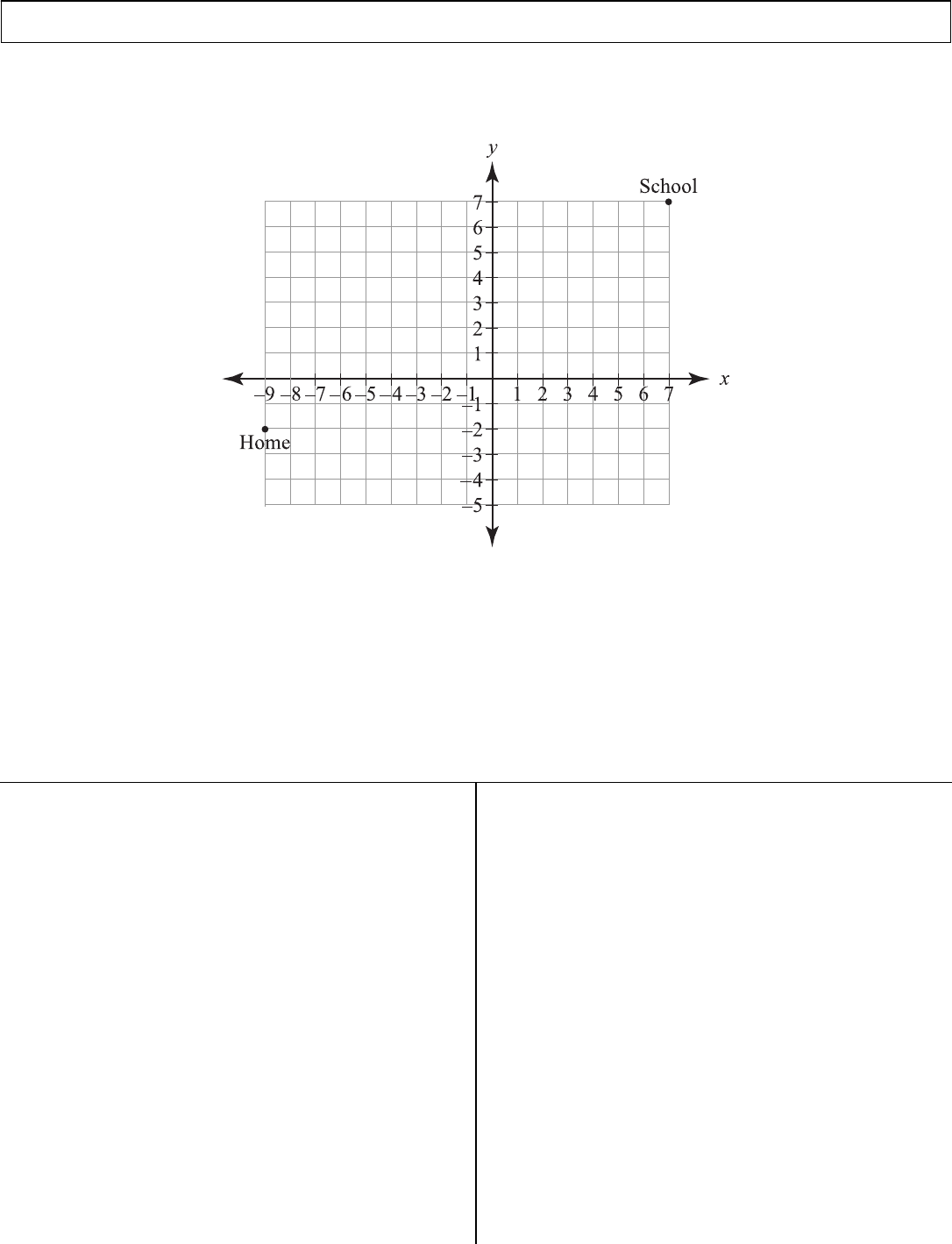
PART II Released Al
g
ebra I Items
ARAM06S0207Y279-279C
26. If the scale of the coordinate plane below is 1 mile = 4 grid spaces, what is the distance between the house
and the school, to the nearest mile?
A. 1 mile
B. 3 miles
* C. 5 miles
D. 19 miles
ARAM03L0102NXXX-113C
27. Susie’s monthly cell phone rate is $14.99 plus
$0.05 per minute. Markus spends $19.99 per
month plus $0.02 per minute on his cell
phone. This month, Markus and Susie have
used the same number of minutes. Which
represents their combined bills in terms of the
number of minutes (m)?
A. $0.07m
B. $15.04m + $20.01m
* C. $34.98 + 0.07m
D. $34.98 + 0.10m
ARAM06F0307NXXX-351C
28. Line a and line b are graphed on the same
coordinate grid. The slope of line a is 0 and
the slope of line b is undefined. What do these
two lines create?
A. a parabola
B. vertical lines
* C. perpendicular lines
D. a set of parallel lines
9
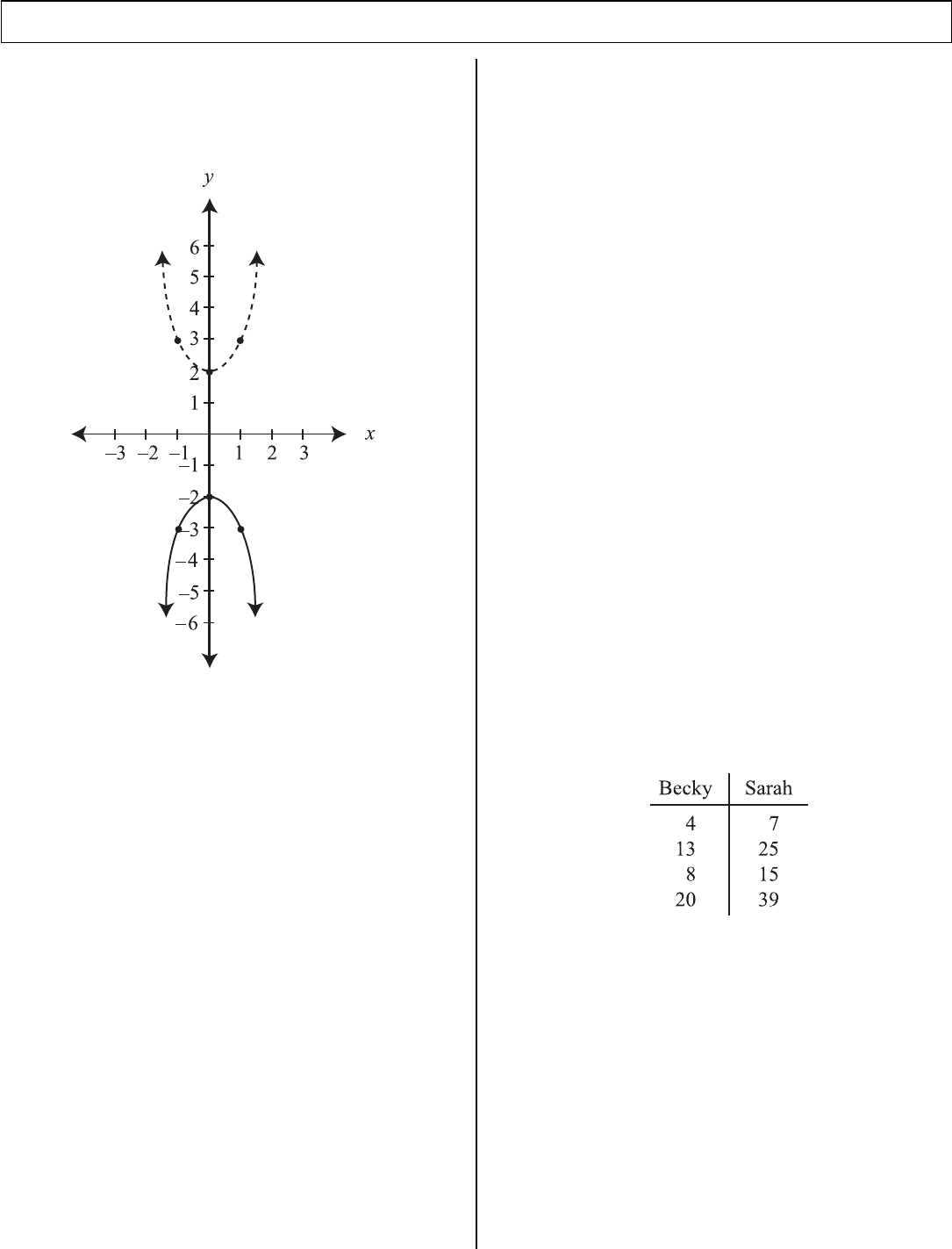
PART II Released Al
g
ebra I Items
ARAM06N0404Y477-477B
29. Compare the graphs of the two functions
below. The solid line is the graph of the
equation y = –x
2
– 2.
Which equation is the graph of the dashed
line?
A. y = –x
2
+ 2
* B. y = x
2
+ 2
C. y = x
2
– 2
D. y = x
2
+ 4
ARAM06S0205NXXX-243C
30. The local animal shelter houses 9 dogs to
every 4 cats. If the total number of dogs and
cats is 104, how many are dogs?
A. 32
B. 40
* C. 72
D. 234
ARAM06F0303NXXX-337D
31. What is the value of f(4) in the function
f(x) = –2x
2
– 6x?
A. –1
B. –2
C. –8
* D. –56
ARAM06N0403NXXX-443A
32. What is the solution for x in the quadratic
equation x
2
– 14x + 49 = 0?
* A. x = 7
B. x = –7
C. x = 49, x = 1
D. x = 49, x = –14
ARAM06D0510Y530-530C
33. Becky is Sarah’s older sister. When they go
jogging together, Sarah realizes that she must
take more steps than Becky to cover the same
distance. Their numbers of steps are shown
below.
According to the data, which describes
Sarah’s steps (S) as a function of Becky’s
steps (B)?
A. S = B + 3
B. B = 2S – 1
* C. S = 2B – 1
D. S = 3B – 9
10
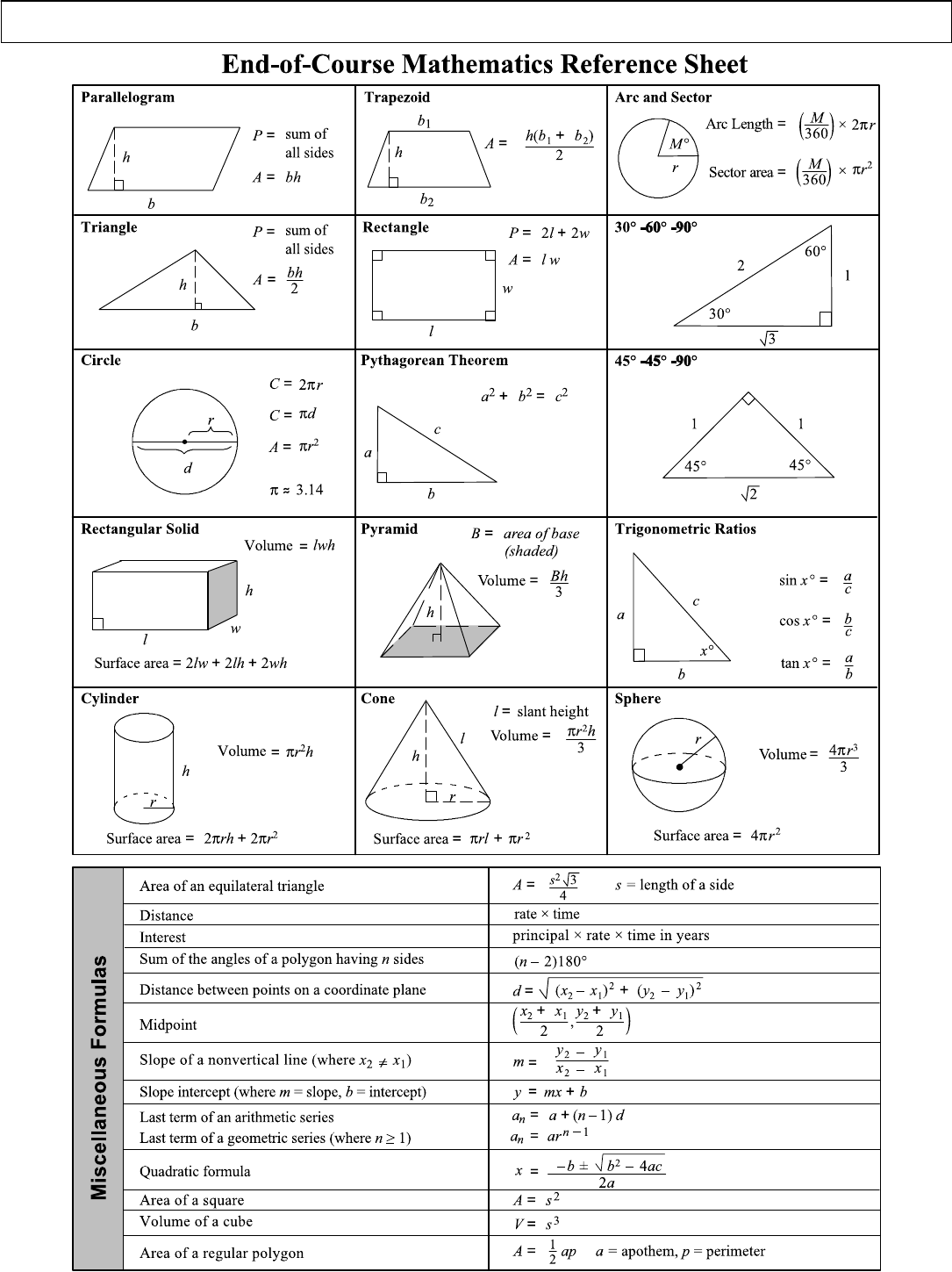
PART II End-of-Course Mathematics Reference Sheet
11
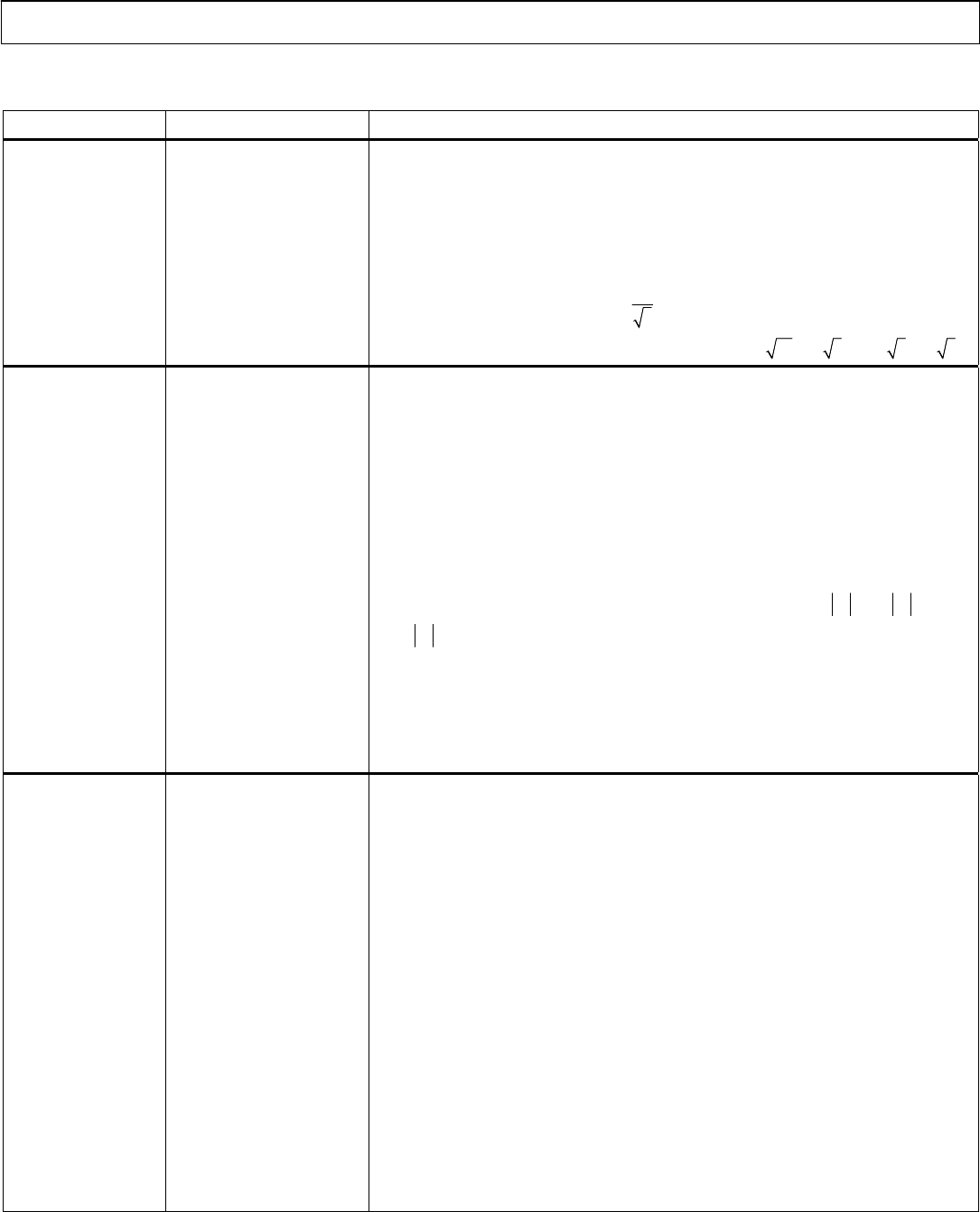
PART III Curriculum Framewor
k
The Arkansas Algebra I Mathematics Curriculum Framework*
Strands Content Standards Student Learning Expectations
1. LANGUAGE OF
ALGEBRA (LA)
1. Students will develop
the language of algebra
including specialized
vocabulary, symbols,
and operations.
1. Evaluate algebraic expressions, including radicals, by applying the order of operations.
2. Translate word phrases and sentences into expressions, equations, and inequalities, and
vice versa.
4. Solve problems involving scientific notation, including multiplication and division.
5. Perform polynomial operations (addition, subtraction, multiplication) with and without
manipulatives.
7. Recognize when an expression is undefined.
8. Simplify radical expressions such as
3
7
.
9. Add, subtract, and multiply simple radical expressions like
320
+
75
and
45
×
23
.
2. SOLVING
EQUATIONS AND
INEQUALITIES
(SEI)
2. Students will write, with
and without appropriate
technology, equivalent
forms of equations,
inequalities, and systems
of equations, and solve
with fluency.
1. Solve multi-step equations and inequalities with rational coefficients
• numerically (from a table or guess and check)
• algebraically (including the use of manipulatives)
• graphically
• technologically
2. Solve systems of two linear equations
• numerically (from a table or guess and check)
• algebraically (including the use of manipulatives)
• graphically
• technologically
3. Solve linear formulas and literal equations for a specified variable. Ex. Solve for p in I = prt.
4. Solve and graph simple absolute value equations and inequalities. Ex.
=
5x
,
≤
5x
,
> 5x
5. Solve real-world problems that involve a combination of rates, proportions, and percents.
6. Solve problems involving direct variation and indirect (inverse) variation to model rates of
change.
7. Use coordinate geometry to represent and/or solve problems (midpoint, length of a line
segment, and Pythagorean Theorem).
8. Communicate real-world problems graphically, algebraically, numerically, and verbally.
3. LINEAR FUNCTIONS
(LF)
3. Students will analyze
functions by investigating
rates of change,
intercepts, and zeros.
1. Distinguish between functions and nonfunctions/relations by inspecting graphs, ordered pairs,
mapping diagrams, and/or tables of data.
2. Determine domain and range of a relation from an algebraic expression, graphs, set of
ordered pairs, or table of data.
3. Know and/or use function notation, including evaluating functions for given values in their
domain.
5. Interpret the rate of change/slope and intercepts within the context of everyday life.
Ex. telephone charges based on base rate (y-intercept) plus rate per minute (slope)
6. Calculate the slope given
• two points
• the graph of a line
• the equation of a line
7. Determine, by using slope, whether a pair of lines are parallel, perpendicular, or neither.
8. Write an equation in slope-intercept, point-slope, and standard forms, given
• two points
• a point and y-intercept
• x-intercept and y-intercept
• a point and slope
• a table of data
• the graph of a line
9. Describe the effects of parameter changes, slope, and/or y -intercepts, on graphs of linear
functions and vice versa.
* The Content Standards and Student Learning Expectations listed are those that specifically relate to the released test
items in this document.
12

PART III Curriculum Framewor
k
The Arkansas Algebra I Mathematics Curriculum Framework* (continued)
Strands Content Standards Student Learning Expectations
4. NON-LINEAR
FUNCTIONS
(NLF)
4. Students will compare
the properties in the
family of functions.
1. Factor polynomials.
• greatest common factor
• binomials (difference of squares)
• trinomials
2. Determine minimum, maximum, vertex, and zeros, given the graph.
3. Solve quadratic equations using the appropriate methods with and without technology.
• factoring
• quadratic formula with real-number solutions
4. Recognize function families and their connections, including vertical shift and reflection over
the x-axis.
• quadratics (with rational coefficients)
• absolute value
• exponential functions
5. Communicate real-world problems graphically, algebraically, numerically, and verbally.
5. DATA
INTERPRETATION
AND
PROBABILITY
(DIP)
5. Students will compare
various methods of
reporting data to make
inferences or predictions.
1. Construct and use scatterplots and line of best fit to make inferences in real-life situations.
2. Use simple matrices in addition, subtraction, and scalar multiplication.
3. Construct simple matrices for real-life situations.
4. Determine the effects of changes in the data set on the measures of central tendency.
5. Use two or more graphs (i.e., box-and-whisker, histograms, scatterplots) to compare data
sets.
7. Recognize linear functions and non-linear functions by using a table or a graph.
8. Compute simple probability with and without replacement.
9. Recognize patterns using explicitly defined and recursively defined linear functions.
10. Communicate real-world problems graphically, algebraically, numerically, and verbally.
* The Content Standards and Student Learning Expectations listed are those that specifically relate to the released test
items in this document.
13
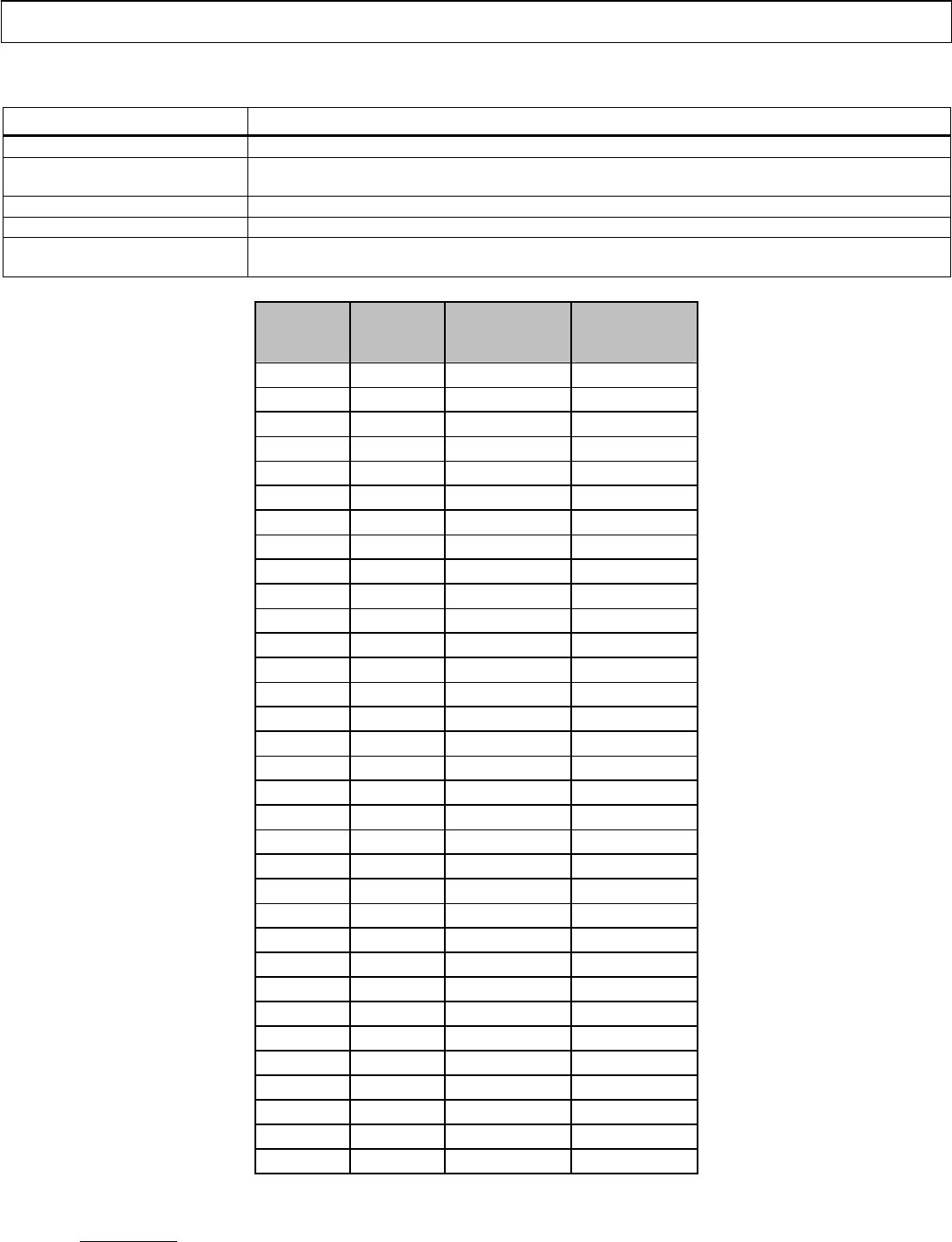
PART IV Item Correlation with Curriculum Framewor
k
Released Items for Algebra I*
Strands Content Standards
1— Language of Algebra (LA) 1. Students will develop the language of algebra including specialized vocabulary, symbols, and operations.
2— Solving Equations and Inequalities
(SEI)
2. Students will write, with and without appropriate technology, equivalent forms of equations, inequalities, and
systems of equations, and solve with fluency.
3— Linear Functions (LF) 3. Students will analyze functions by investigating rates of change, intercepts, and zeros.
4— NON-LINEAR FUNCTIONS (NLF) 4. Students will compare the properties in the family of functions.
5— DATA INTERPRETATION AND
PROBABILITY (DIP)
5. Students will compare various methods of reporting data to make inferences or predictions.
Item Strand
Content
Standard
Student
Learning
Expectation
1 LF 3 1
2 SEI 2 1
3 DIP 5 9
4 DIP 5 1
5 LF 3 3
6 NLF 4 4
7 NLF 4 1
8 LF 3 6
9 DIP 5 2
10 LF 3 5
11 NLF 4 2
12 DIP 5 4
13 LF 3 3
14 LA 1 1
15 NLF 4 1
16 SEI 2 3
17 SEI 2 2
18 LA 1 7
19 LA 1 5
20 NLF 4 1
21 SEI 2 4
22 LA 1 8
23 DIP 5 3
24 LF 3 6
25 LA 1 1
26 SEI 2 7
27 LA 1 2
28 LF 3 7
29 NLF 4 4
30 SEI 2 5
31 LF 3 3
32 NLF 4 3
33 DIP 5 10
*Only the predominant Strand, Content Standard, and Student Learning Expectation are listed for the Algebra I items.
14
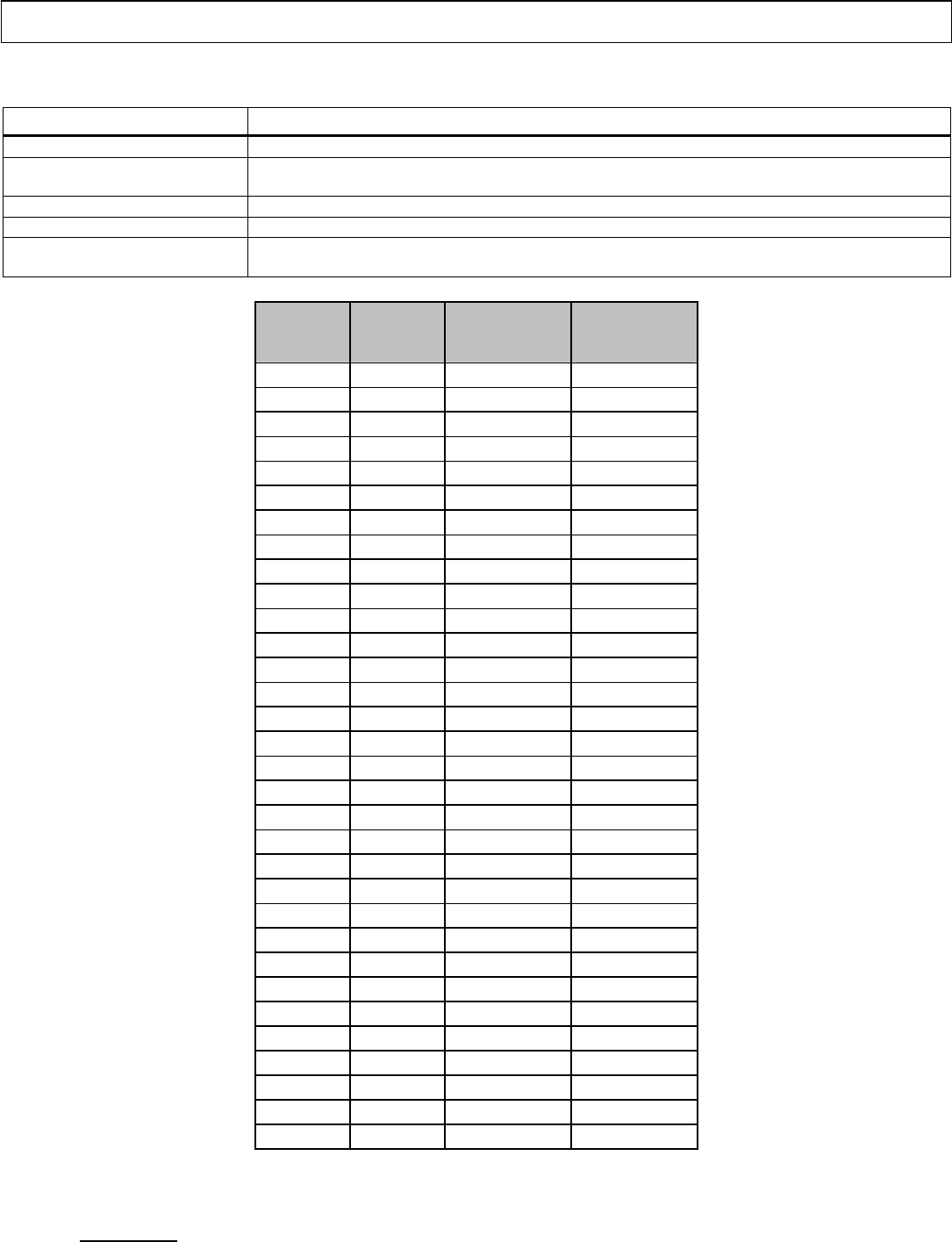
PART IV Item Correlation with Curriculum Framewor
k
Non-Released Items for Algebra I*
Strands Content Standards
1— Language of Algebra (LA) 1. Students will develop the language of algebra including specialized vocabulary, symbols, and operations.
2— Solving Equations and Inequalities
(SEI)
2. Students will write, with and without appropriate technology, equivalent forms of equations, inequalities, and
systems of equations, and solve with fluency.
3— Linear Functions (LF) 3. Students will analyze functions by investigating rates of change, intercepts, and zeros.
4— NON-LINEAR FUNCTIONS (NLF) 4. Students will compare the properties in the family of functions.
5— DATA INTERPRETATION AND
PROBABILITY (DIP)
5. Students will compare various methods of reporting data to make inferences or predictions.
Item Strand
Content
Standard
Student
Learning
Expectation
1 LA 1 1
2 DIP 5 2
3 LF 3 2
4 LA 1 1
5 SEI 2 5
6 NLF 4 4
7 LA 1 2
8 DIP 5 3
9 SEI 2 2
10 LA 1 4
11 NLF 4 5
12 DIP 5 2
13 SEI 2 3
14 LF 3 8
15 NLF 4 2
16 SEI 2 8
17 DIP 5 5
18 LF 3 5
19 DIP 5 8
20 LF 3 3
21 NLF 4 2
22 DIP 5 7
23 SEI 2 6
24 LF 3 9
25 NLF 4 5
26 SEI 2 8
27 LA 1 9
A DIP 5 1
B LF 3 6
C LA 1 1
D NLF 4 1
E SEI 2 5
*Only the predominant Strand, Content Standard, and Student Learning Expectation are listed for the Algebra I items.
15

A TAAP
Arkansas Comprehensive Testing, Assessment, and Accountability Program
DevelopeD for the ArkAnsAs DepArtment of eDucAtion, little rock, Ar 72201
QAI03408 RIB-A AR0806
